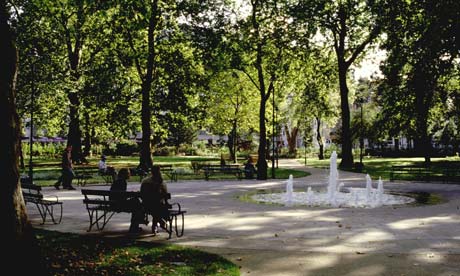
Despite being surrounded by busy roads, Russell Square gardens remains an oasis of tranquillity amid the clamour of modern London. Designed by Humphry Repton at the beginning of the 19th century, it lies in the heart of Bloomsbury, whose Georgian brick terraces and garden squares were described by the art historian Sigfried Giedion as an architectural composition that is the equal of St Peter's Square in Rome or the Place de la Concorde in Paris.
Squares are arguably London's most significant contribution to the development of urban form (there are some 300 in Greater London). Inspired by the Italian piazza, they were introduced in the 17th century as a way of creating open spaces at the centre of London's new residential neighbourhoods. But it was not until the following century that their gardens were enclosed and the gates locked against the "rudeness of the populace". Todd Longstaffe-Gowan, a landscape architect, detects the seeds of later urban trends in the emergence of these garden squares: "Squares and their surrounding residential districts were among the first expressions of the desire for class segregation, domestic isolation and private open space – aspirations that would later form the basis for suburban living both in Britain and abroad."
It's hard to believe now, but before 1630 Leicester Fields (later Square) was meadow land. Then the second Earl of Leicester, Robert Sidney, leased the fields and enclosed part of the land for building. The King compelled him to recompense the parishioners by creating an area of tree-lined walks and "fitt spaces … for the Inhabitantes to drye their Clothes there as they were wont, and to have free use of the place". Leicester House was built to the north of the land and around the edges the Earl began developing houses, leaving the centre free. Initially, developers viewed these central spaces as a form of street widening. They were not enclosed or even planted. As London grew ever larger, more such developments followed on the suburban fringes, such as Bloomsbury (formerly Southampton) Square, which was planned in about 1647. Soon squares were being built not just for the aristocracy, but for the professional classes too, as at Crosby Square (1671), off Bishopsgate in the City, and Hoxton Square (1683).
At Soho Square (1676) the lessees had to pay towards the upkeep of "Rayles, Payles, Fountaine and Garden". But it was thanks to the square's garden, which was laid out for promenading, that it became a fashionable address. Such grassed squares were not, however, transformed into true gardens until the early 18th century, when fears about criminality in the expanding metropolis and new ideas about gardening led to squares being enclosed and planted with those shrubs and trees, such as lilac, elm and honeysuckle, that could survive London's polluted air. Daniel Defoe observed "new Squares and new streets rising up every day". The open fields to the north and west of the capital became Queen, Hanover, Cavendish and Grosvenor Squares. The latter quickly became the "pinnacle of social prestige", its oval garden reserved exclusively for the use of the key-holding inhabitants. Soon the city's squares had become its defining feature, praised at home and abroad.
By the early 19th century, Longstaffe-Gowan writes, a "staggering" number of squares were being planned, many in the suburbs. They were "the sine qua non of development at this time" and were "synonymous with privilege, elegance and prosperous metropolitan living". Attitudes, however, were slowly changing. People began to resent the system of social privilege these exclusive, gated enclaves represented. In 1861 the French press complained that "the immense and numerous squares of London … are rigorously shut against the working classes". It was a sign that the heyday of the London square had passed. The Victorian middle classes increasingly demanded a more informal style of living – suburban houses with their own private back gardens. London's wealthy also began moving into serviced mansion blocks or leaving the city entirely.
In the 20th century, these "miniature Elysian fields", as one author described them, were often sadly neglected, becoming overgrown jungles. In wartime they suffered the indignity of being dug up for air-raid shelters, turned into allotments and having their iron railings melted down to make armaments. Repton's timber "reposoir" in Russell Square gardens was destroyed by a flying bomb. In the 1960s the University of London (which should have known better) proposed demolishing the Georgian cityscape of Bloomsbury and replacing it with a university precinct. Thankfully, since the 1990s, there has been a resurgence of interest in London's squares and some £25m has been spent on them. They are now better maintained than they have been for over a century. Longstaffe-Gowan's beautifully illustrated and lovingly researched history is an appropriately impressive celebration of "England's most innovative and most universally admired urban landscape conceit".
• PD Smith's City: A Guidebook for the Urban Age is published by Bloomsbury.

